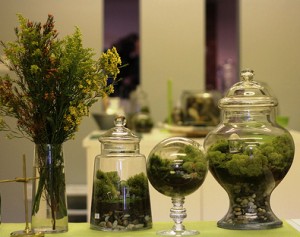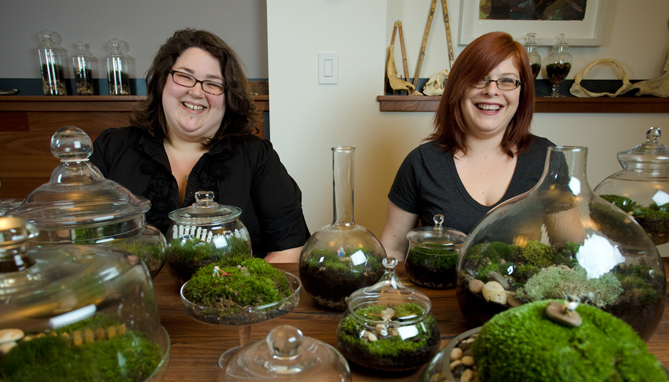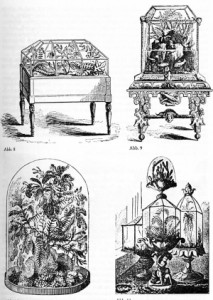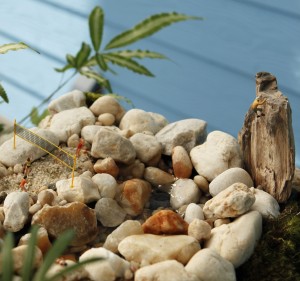Little Landscapes: The World in a Jar
Posted in Learning Experiences, Programs and Events on March 19 2012, by Matt Newman
 Gardening isn’t always a cakewalk. For New Yorkers, it can be the supreme struggle. Back yard vegetable plots are replaced with cramped fire escape terra cotta, and a window sill planter sits in for the shady garden tree. In light of the trouble with greening a studio apartment the size of your childhood closet, it’s no shock that the terrarium is coming back into vogue. And with Little Landscapes, the valedictorians of terrarium design are bringing the craze to The New York Botanical Garden.
Gardening isn’t always a cakewalk. For New Yorkers, it can be the supreme struggle. Back yard vegetable plots are replaced with cramped fire escape terra cotta, and a window sill planter sits in for the shady garden tree. In light of the trouble with greening a studio apartment the size of your childhood closet, it’s no shock that the terrarium is coming back into vogue. And with Little Landscapes, the valedictorians of terrarium design are bringing the craze to The New York Botanical Garden.
The ladies of Twig understand the plight of the urban green thumb. Wearing the varied hats of the antique aficionado, the photographer, and the writer between the two of them, cooperative gardening was nowhere on the radar early in their working relationship. They are self-described “junkers.” Weekends were (and still are) spent picking through heaps of decades-old kitsch for secret treasures of myriad provenance. But a chance suggestion by Michelle Inciarrano, the plant-minded of the two, struck just the right note. With Katy on board, they transformed themselves from hobbyists to entrepreneurs.
“I had not thought of terrariums once in my whole life,” Katy Maslow told The New York Times. But in short order the duo was repurposing their many found bell jars and decanters into miniature greenscapes. Mosses, tropical flowers, and desert succulents found their way into all manner of glass enclosure–whatever was translucent and spacious enough to hold growing life. And with so many of the creations piling up around their respective apartments, Michelle and Katy made the inevitable move to business. Twig was established in Brooklyn as a terrarium fanatic’s ultimate destination.

The concept of the terrarium is, of course, a simple one. However, its history is richer than an unassuming coffee table decoration might suggest, and its initial invention fell far from the cradle of home design inspiration. It actually began well back in 1829 with the Wardian case.
Dr. Nathaniel Ward, a British physician, had a hobby of caring for moth cocoons in jars, and it was here that he found a very different type of resident flourishing. A fern spore had made its way into the container and germinated in the small spread of soil that was kept at the bottom. Not that this was startling in itself–as an amateur botanist, Ward kept a collection of nearly 25,000 ferns. But as his London garden was choked by the industrial coal and sulfur pollution that plagued the city, it was rare to see such a delicate plant surviving there. He kept the jar sealed for four years as an experiment.

The fern ultimately died, but not due to neglect. The jar’s cap simply rusted through. The fact that the fern had survived for so long in its isolated environment spurred Ward to action, and with the help of a skilled local craftsman, he designed and built the first Wardian case–a glazed wood and glass enclosure that was sealed to protect its inhabitants from outside pollution. The doctor found that the design effectively created a miniature biome, with its own self-regulating water cycle to sustain the plants inside.
From this point on, horticultural practices were changed on a global scale. Sensitive foreign plants which would otherwise die on long ship voyages–withering in dark holds in an attempt to hide them away from salty air and seawater–were now surviving their trips on the sunny deck, tucked safely inside large Wardian cases. It was solely because of Ward’s discovery that the British Empire was able to smuggle mature Camellia sinensis plants out of China and into Imperial British India, creating an agricultural industry which still provides much of the world’s tea. Closer to home, the “pteridophilia” of Victorian London–the fern craze–was growing exponentially. Wardian cases became not only a blessing to botanical science and industry, but to the social status and design savvy of well-to-do English homeowners.
What evolved into the terrarium is not often as dramatic or intricate as the Wardian case, with its individual glass panes suspended within an iron or wood framework, but the planting technique hasn’t changed much. Katy and Michelle recommend only a few main ingredients for a successful microcosm of green life.
With an appropriate container, you can make your own terrarium with a handful of pebbles, some soil, dried sphagnum or burlap, and a spread of fresh moss; adding small figurines and other accents earns you bonus points for creativity. But the moss terrarium, while my personal favorite, is only one of the many options out there–all sorts of plants can be raised in glass, from desert succulents to flowering tropical exotics.

Running from now until April 22, the Everett Children’s Adventure Garden will be hosting Little Landscapes in a partnership with the generous folks at Twig. And as part of this pairing, Katy and Michelle were kind enough to visit our Discovery Center glasshouse, where they have imaginatively constructed a few large terrariums to show visitors just how lush and ambitious a project can be.
But the true benefactors here are the kids: our on-site staff will be available throughout the week to introduce your little ones to the art and science of these tiny worlds, and even help them create some of their own. For the family looking to take up the hobby as a group, Twig’s capable creatives will also be holding focused workshops here at the NYBG between April 11 and 12, while our Adult Education programs often feature terrarium-building courses as well. Be sure to check in throughout the year for updates to our offerings.
Even if you would prefer to learn the terrarium craft on your own time, or simply take one home without having to piece it together from scratch, we have every corner covered. Maria Colletti at the NYBG’s Shop in the Garden has been our go-to terrarium designer for years, and can help you choose one of our finished pieces or quickly put together all the materials you’ll need to get from start to finish by yourself. She’s a talented artist when it comes to miniature landscapes–don’t overlook the value of her input!
Oh, and one final disclaimer: we make no promises that you’ll avoid a complete terrarium obsession. Get your tickets soon!
Twig photos courtesy of Robert Wright and TwigTerrariums.com; Wardian case illustrations courtesy of Wikimedia Commons.


Fascinating, thank you and good luck to the good ladies of Twig.